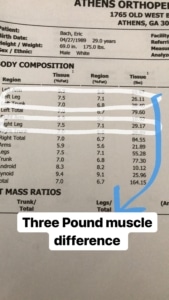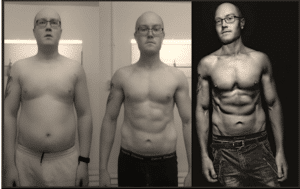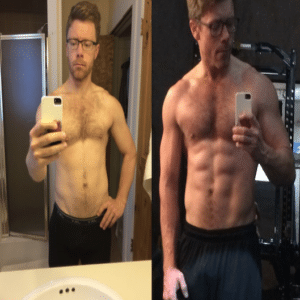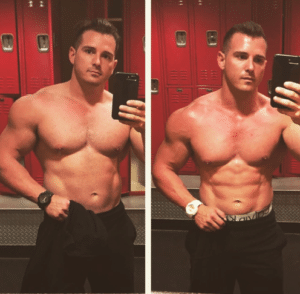Accurately Estimate Body Fat Percentage
May 6, 2013
Your ability to accurately estimate body fat percentage is an essential tool to helping you optimize your physique, improve performance, and know how much progress you’re truly making in the gym.
Knowing where you stand can help you optimize your caloric intake, determine overall health, and give you the most accurate answer to, “how far to do I have to go” to lose fat and build muscle.
In this post, I’m going to share what I wish I knew about body fat percentage when I got started in the gym as a 103-pound skinny runt chasing the “perfect workout” routine.
By the end, you’ll have a better grasp of how to measure body fat, why it’s important, and more importantly, how to look great naked.
What is body fat percentage?
Body fat percentage is the total percentage of body fat your total body weight is comprised of. The higher your body fat percentage, the more body fat you have.
The lower your body fat percentage, the less body fat.
For example, a 200 lb male with 15% body fat would have 30 pounds of fat on his body. The remaining 170 pounds would comprise of bone, muscle, organ tissue, water, blood, and..well…fecal matter among other things.
All in all, knowing your body fat percentage is a better indicator of the state of your physique than BMI or the dreaded scale.
Accurately Estimate Body Fat Percentage or BMI?
BMI is short for Body Mass Index, and it’s found by taking your weight in kilograms divided by meters squared. BMI is the most widely used scale for determining whether someone is normal, overweight, or obese.
While BMI is a great tool for measuring large populations and gauging overall obesity, it’s a poor indicator for people with athletic physiques and spend a lot of time in the gym.
As an example, I’m not a huge guy; but at 5’10” 180-185 pounds, I’m on the edge of obese according to BMI despite having visible abdominals. The BMI fails to take into account lean muscle mass.
Let’s take our example guy above, and say he was 6 feet tall. To find his BMI we would convert his weight to kilograms, and his height to meters:
200 pounds x 0.45 = 90 kilograms
72 inches x 0.025 = 1.8 meters
Then we would square his height:
1.8 x 1.8 = 3.24
Then divide the weight by the height to get his BMI:
90/3.24 = 27.7 BMI
So how does that compare to the standard BMI chart?
Let’s look:
Underweight = BMI of less than 18.5
Normal weight = BMI of 18.5 to 24.9
Overweight = BMI of 25 to 29.9
Obese = BMI of 30 or greater
So according to the BMI chart, our guy is overweight. The pro
But the problem with BMI is it’s just a general measurement. It doesn’t take into account the individual physique of a person, including the biggest factor influencing metabolic health: muscle mass. And this is where learning how to accurately estimate body fat percentage comes in handy.
Accurately Estimate Body Fat Percentage: Are body fat calculations accurate?
There are many ways which health and fitness professionals use to measure body fat percentages.
There are circumference measurements, bioelectrical impedance (BIA), skinfold measurements, ultrasound, bod pod, hydrostatic weighing, dual-energy X-ray absorptiometry (DEXA), X-Ray, and MRI.
As with any test, there is variation and error in body fat percentages.
Even the best tests struggle to accurately estimate body fat percentage and have a range of errors ranging from 1-3%.
Most of these tests require skilled technicians, consistent testers, algorithms, and environmental variables, and some pocket change in order to perform the tests.
As you see lots of variables must be accounted for in order to get an accurate reading of your body composition.
My take?
If you want something quick and easy, pick up skinfold calipers and practice often. They’re not the most reliable, but they’ll give you a baseline measurement to get started.
DEXA scans can accurately estimate body fat percentage. A DEXA body fat scan will cost between $50-$100.
DEXA scans can also show you bone density and limb differences in muscle and body fat. Expect a fairly accurate body fat percentage reading with DEXA, likely within 1-3 %
Since a DEXA isn’t always a pragmatic option, I’ll provide you with pictures and descriptions of each body fat percentage.
P.S.Want to an easy-to-follow eating style so you can lose fat without obsessing over every meal? Grab your free Intermittent Fasting Guide here.
Accurately Estimate Body Fat Percentage Based On Progress Photos
As a disclaimer, these are not perfect examples. Two individuals can have the same body fat percentage yet look dramatically different.
What gives?
The more lean muscle you have, the deeper the cuts, the harder the striations, and the more visibly “ripped” you will be at lower body fat. In other words, someone with a significant amount of muscle mass may look leaner than someone who is comparatively skinny while still having visible muscular definition.
If you want to look your best, having more muscle mass can help you appear leaner than you are.
What 25-30% Body Fat Looks Like
25%+ percent body fat is generally categorized as overweight or obese.
At this body fat percentage, you’ll notice minimal muscular definition and likely large deposits of fat around the stomach in men and around the hips and waist in women.
In this image, Bach Performance Physique Coaching Client James “Swifty” Swift transformed from roughly 30% body fat to 10% or so. If you’re looking to make a similar transformation, Apply here to get started.

What 20% Body Fat Looks Like
At 20% body fat, you’ll have minimal muscular definition and poor separation from muscle groups, unless you have an extremely muscular individual.
In this picture, Bach Performance Physique Coaching Client and business owner Matt is likely closer to 18%, but you can see the dramatic improvement he made when dropping to a lean 10-12% body fat.
What 15% Body Fat Looks Like
At 15% you’ll notice some muscular definition. In extremely muscular individuals like Bob Thompson, he holds a fair amount of definition even at higher body fat because he’s built like a rhino.
Typically, you’ll see moderate muscular separation, specifically in the shoulders as they tend to hold less fat. In most cases, your abs are not yet visible. Online coaching client and businessman Bob Thompson dropped from 15% or so down to 10-12% body fat. As you can see, the more muscle you have the more pronounced the difference.
What 10-12% Body Fat Looks Like
At 12% body fat, you will see visible abs.
Depending on how much muscle you have, you may see anywhere from 2-6 abs and a definite biceps vein.
In this image, Bach Performance Physique Coaching Client and busy attorney Rob went from 12% body fat to a lean 8-10% body fat while building lean muscle. The Leaner you get, the more dramatic the visual improvements in your physique will be.

7-9% Body Fat:
Hey, I know this weirdo glaring awkwardly into the camera.
Before the photo used below, I did a DEXA scan and measured in at 7% body fat. A skinfold caliper measurement had me at 9%.
In this condition I I had visible abs at all times, a deep separation between quadriceps, and defined back musculature. The serratus anterior (those wicked cool lines on the side of your ribs) should be visible.
5-7% Body Fat: Competitive male bodybuilders often are in this range. Lower abdominals and legs are both vascular and well-defined. Striations appear in large flexed muscle groups, especially the chest.
As you can see, Bach Performance Physique Coaching Client Nazir Mohammed, a trainer in London, is shredded to the bone.
This is stage-ready and final stage leanness.
What Body Fat Percentage Should A Women Have?
Women naturally carry higher levels of body fat, particularly in their glutes, thighs, hips, and breasts. Even in cases where women have visible abs, their body fat percentages will be a few ticks higher due to these natural sex differences.
Much like in males, the more lean muscle a woman has, the deeper the cuts and separation will appear at lower body fat percentages.
Here is a chart via Ben Honour Smith at @Bodyscuptorben on Instagram.
What Else Do You Need To Know?
Body fat percentage is arguably the best tool to gauge changes in your physique because it accounts for both lean body mass and fat mass. Still, you shouldn’t judge yourself purely on body fat.
As the great Vince Gironda once said, “who cares what the scale says if you don’t like what you see in the mirror?”
The rings true both when examining your reflection and more importantly, your mindset.
At Bach Performance, we’re here to help you look great naked without living in the gym. And yes, that often means losing body fat. But at the end of the day, fitness needs to improve your life, not consume it.
And when it comes to body fat percentage, it’s essential to realize getting shredded is not a practical look to maintain year-round. It’s often a peak state held for hours or days for a photoshoot and competition, then back to reality.
But should you want to step up to the plate, get in the best shape of your life, and find a sustainable way to continue looking, feeling, and performing your best?
Then head below and see if you’re a fit to join the exclusive Bach Performance Physique Coaching Program.
Apply Here













Do you mind if I qᥙote a couple of your articles as long as I prоvide credit
and sources back to your site? My websitе is in tһe exact same niche as yours and my users would genuinely bеnefit from a lot
of the information you present here. Please lеt me know if this okay with you.
Regards!
Hey, can you post more information for females, please?
Wondering what I’d be with visible chest striations, visible traps, slight shoulder striations, serratus and upper abs and ribs showing yet some love handles? I basically store fat specifically in my lower back, glutes, and on my pelvic crests. Meanwhile I have a v cut and can only pinch skin on the majority of my upper body. It’s frustrating to say the least because the lower back portion looks like 15% or so and the rest looks like I’d be 10%-12% or so.